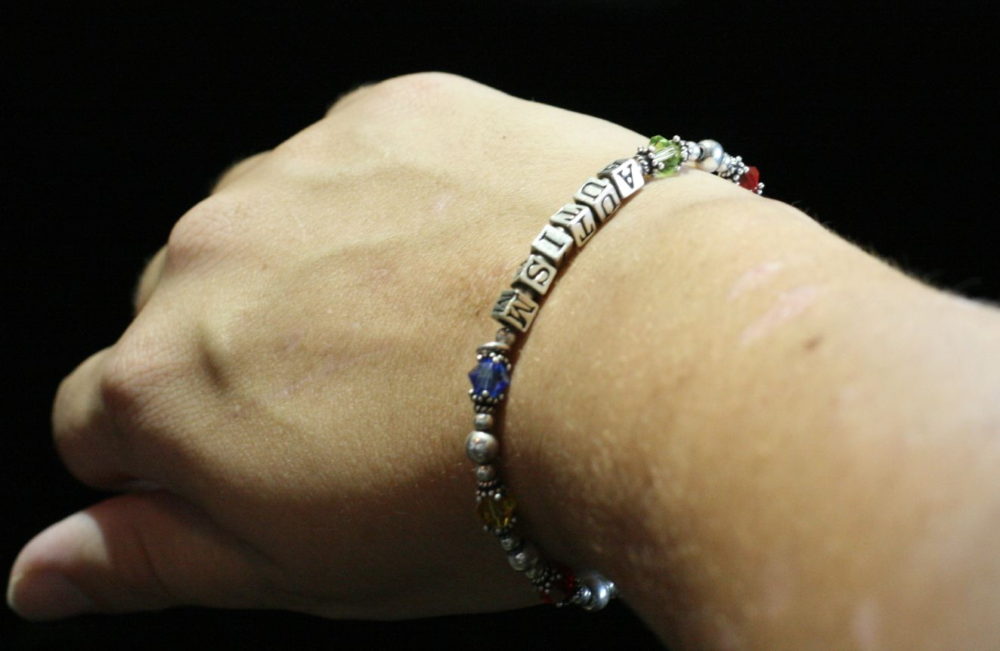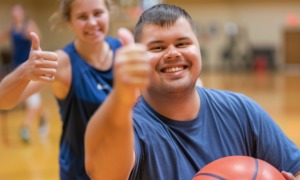From pre-kindergarten through second grade, the now 20-year-old New Jersey man was among roughly a dozen special education students in his public school classrooms, helmed by a special education teacher and two teaching assistants. In addition to learning the alphabet and other fundamentals taught to all pre-K through second-graders, whether or not they were officially enrolled in special ed, he received therapy for his speech, reasoning and other cognitive skills and to regulate his social behavior.
 From third through fifth grades, as that kind of instruction and assistance continued, he was among five children with special needs in a classroom with a teacher not trained in special education, one teaching assistant with a background in special education and 25 classmates who didn’t require special education.
From third through fifth grades, as that kind of instruction and assistance continued, he was among five children with special needs in a classroom with a teacher not trained in special education, one teaching assistant with a background in special education and 25 classmates who didn’t require special education.
During sixth and seventh grades, as he moved from classroom-to-classroom to take math, science, English, history and physical education, none of his teachers were trained in special ed. During his last four years in public schools, his key special education classroom services had diminished so severely — his speech and behavioral therapies continued — that he graduated high school wholly unprepared for college.
“I had a lot of catching up to do,” said Eric, that 20-year-old, who asked that his last name not be used to protect his privacy.
“My son didn’t receive failing grades,” said Eric’s mother, who asked to go unnamed. “Every report card had a ‘P’ for passing — no As, Bs or Cs. It meant he was passed from grade to grade. He did receive all of the special services such as speech therapy, behavior to regulate his emotions, social skills and occupational therapy. I saw improvement in some of those areas. He just didn’t receive an adequate education in academics.”
Eric’s lack of preparation for the next level in his education and, more broadly, his young adult life is hardly rare.
The problem traces, for starters, to the fact that many teachers in classes enrolling both special ed and non-special students aren’t trained to work with students with special needs, said Leslie Calabrese, of Rutgers University’s Graduate School of Education Community School Partnership Network.
“Plus, they don’t get the support they need,” Calabrese said of those special education teachers. “They are pulled in so many directions.”
Lack of national standards for special education; a nationwide shortage of special education teachers; and the comparatively short tenure of those teachers all factor into how special education students leave schools without skills that many of them need, she and other observers say.
In 48 states, there weren’t enough special education teachers
Forty-eight states and the District of Columbia lacked enough of those special instructors, according to a report from American University’s School of Education. On top of that, special education teachers leave their profession at almost double the rate of general education teachers; and 90% of high-poverty school districts struggle to hire well-qualified special education teachers.
“The average amount of time a special education teacher stays in the field is five years,” said Bridgette Leslie, who ended 10 years as a special educator in California classrooms to launch IEP & Me, a consultancy aiding special education teachers, students and parents wanting to assure that their children have an adequate individualized education plan.
Though many students, during the early grades, often receive the intensive, critical learning they need, those services fall off precipitously as they are promoted to upper grades, said Brianna Knight Leonard, a special education teacher in Gwinnett County Public Schools in Georgia. “The ability to close an achievement gap for a student performing well below grade level at age 10 or older is developmentally unachievable in most cases,” she said.
One crucial result of that, according to a 2015 report from Drexel University’s Autism Institute, is that 35% of 18-year-olds with autism who do go to college still end up in part-time or minimum-wage jobs after they end their college careers. Approximately 85% of autistic adults remain unemployed or underemployed; and as many as nine out of 10 college graduates on the autism spectrum also remain unemployed or underemployed, according to a 2015 study from Chapman University.
A private school for autistic students remediates public high school grads with autism
Eric’s parents enrolled him in a New Jersey private school exclusively for 18- through 21-year-olds with autism. His home school district, as required by law, paid for him to attend Montgomery Academy in Basking Ridge, N.J. It taught remotely during part of the COVID-19. But, with remote learning a bad fit for many of its students, Montgomery is granting Eric and others turning 21 in 2021 or 2022 an additional year of schooling; nationwide, those pandemic-related extensions have been granted to special education students.
“We’re grateful that he’ll have another year. Even with this extra year,” she said, regarding Eric, who spoke his first intelligible words when he was five years old, “my son isn’t prepared for the next stage, which would be college or work.”
Nationally, one in 54 children have an autism diagnosis. Children with autism have one or more physical and/or mental health conditions, ranging from speech delays to attention deficit hyperactivity disorder to anxiety. When grouped with mainstream students, teachers often teach to the proverbial middle of the classroom, leaving the special needs of many special ed students unmet.
Many schools have failed, said Rutgers professor Calabrese, to create an individualized education plan that strategically maps how student learning will aid their transition from grade to grade, then, to graduation and the next steps beyond that. Those plans often need to be tweaked as a student ages and their development shifts, whether forward or backward.
Additionally, not everyone who needs such a plan winds up getting one, though there is no precise tally of how many students go without.
“Costs are a common concern,” Calabrese added. “They range broadly for teachers, special education teachers, paraprofessionals, personal aides for each child who needs one, occupational, speech, physical and behavior therapists. And those costs vary from state to state.”
The yearly expenditures for each special education student in New Jersey ranges from $21,000 to more than $50,000 per student, though additional fees may differ by county and state.
The National Center for Education Statistics found, in 2018, that 95% of 6- to 21 year-old students with disabilities remained in public schools. A fraction of students, just 3%, end up enrolling in private schools they presume will better prepare them to not be on the margins of college education or employment paying a decent wage.
As parents try to fill gaps, special schools hone skills and provide entry-level internships
“I’m fortunate,” Eric’s mom said. “I work part time so I can attend IEP meetings, talk to my child’s teachers and therapists and take my child to outside therapies, which I do to supplement what he’s getting in school.”
Eric also receives private speech therapy after school, which his parents pay for out-of-pocket. They felt the twice weekly therapy he was getting wasn’t sufficient. Thirty-minute to hourlong speech therapy sessions can cost $60 to $120 each. Some, but not all, health insurance companies cover private speech, physical, occupational and behavioral therapies.
“I wish I spent time tutoring him in academics,” Eric’s mom said. “I know I can’t help him in many of his subjects, such as math and science. And not all parents have the time to be involved. We do our best. I’m in a few autism awareness chat rooms and parents complain they work long hours and don’t have time to follow up with their children’s academics.”
Sally Bell, a special educator at Eric’s private academy, said it’s good that many of its students do attend community college part time. But, she added, “Unfortunately, most colleges and universities don’t offer special services.”
Like other programs for special education students who’ve already graduated high school, Montgomery Academy offer its students classes in budgeting and social skills. It puts them in the pipeline for entry-level internships at hotels, restaurants, farms, grocery stores, senior centers, retail shops and libraries. “They’re learning basic skills, which are necessary for when they apply for jobs on their own,” Bell said.
She continued: “Many of our kids have trouble advocating for themselves. They don’t always know how to hold a conversation, a necessary skill when you’re applying to college or for a job. They learn a lot of these skills in internship programs and when they’re not at their internship, they get social skills training here [at Montgomery Academy].”
“It’s not a one solution fix,” said Rutgers’ Calabrese, noting that much more needs to be done to shore up autistic and other special education students nationwide. “Major changes have to be made in order to fix special education and prepare students for the next phase of life. It’s a multi-pronged approach that takes time. Unfortunately, students and teachers need to have these issues addressed quickly.”
































